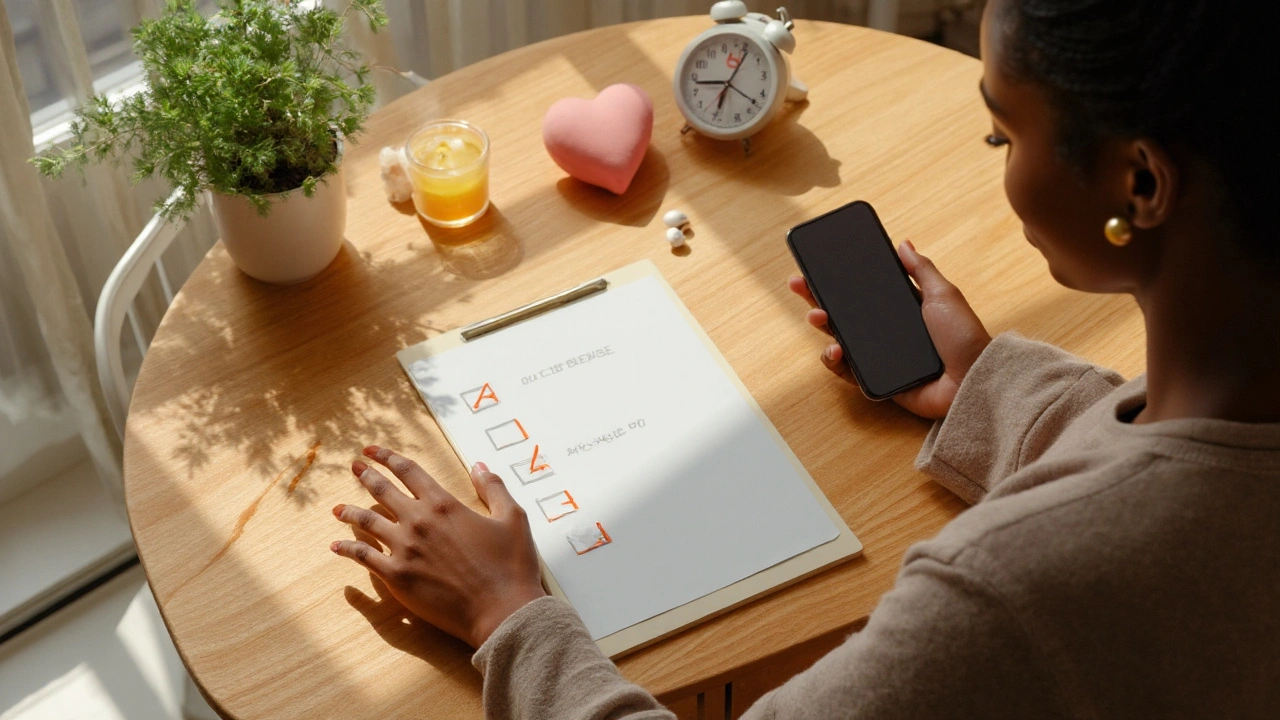Dating can lift you up or knock you flat. It can calm your nervous system with steady support-or flood it with stress from mixed signals, endless swipes, and quiet rejections. This deep dive keeps it real: what dating does to your head and heart, how to spot the patterns, and how to protect your mental health without giving up on love.
What you’ll get: a short answer you can act on today, a practical playbook for healthier dating, evidence you can trust, and clear next steps if you’re running on fumes. Nothing fluffy. No judgment. Just tools.
You’re probably here to:
- Understand the real mental health effects of dating-both the upsides and the downsides.
- Reduce stress from apps, ambiguity, and rejection without checking out.
- Spot patterns like anxious chasing or avoidant shutdown-and change them.
- Use simple boundaries, scripts, and routines to make dating feel sane.
- Know when to pause, and when to talk to a pro.
TL;DR:
- Healthy dating acts like a buffer: social support, shared routines, and kind communication lower anxiety and depressive symptoms (APA Stress in America, 2023; Holt-Lunstad, PLoS Medicine, 2010).
- High churn, ambiguity, and constant comparison raise stress and rumination. App fatigue is real (Pew Research Center, 2023).
- Fix the process: cap swipes, pace intimacy, name your needs early, and debrief after dates. Small systems beat willpower.
- Rejection stings less with a self-compassion script and a 24-hour reset routine. Your mood rebounds faster when you plan it.
- Pause if sleep, appetite, energy, or focus drop for two weeks; use PHQ‑2/GAD‑2 as a quick check and consider pro support.
What Dating Does to Your Brain and Mood
Dating isn’t neutral. It pushes your brain’s reward and threat systems at the same time. Early attraction spikes dopamine and oxytocin. That feels great. But uncertainty and mixed signals trigger cortisol and rumination. The swing between those states is where most people get scrambled.
There’s good news. Supportive relationships-romantic or not-are linked to lower depression and better resilience. A landmark meta-analysis found strong social ties predict longer life (Holt-Lunstad, PLoS Medicine, 2010). And people who feel securely attached report less dating distress and better conflict recovery (Fraley, Psychological Bulletin, 2010).
The flip side: app-driven ambiguity and high rejection exposure take a toll. In recent US surveys, heavy app users report burnout, body image concerns, and safety worries (Pew Research Center, 2023). Correlation doesn’t mean apps cause the harm, but the pattern is consistent: more churn and more comparison usually mean more stress.
Attachment style matters. If you lean anxious, you might chase reassurance and spiral after slow replies. If you lean avoidant, you might detach when feelings grow. Both patterns can trap you in loops that feel like dating is harming your mental health. The goal isn’t to rewrite your whole personality-it’s to spot your loop sooner and add a few guardrails.
Here’s how common dating dynamics map to mental health signals.
| Dating dynamic | Likely mental health effect | What the evidence suggests |
|---|---|---|
| Steady, supportive connection | Lower stress, better mood, better sleep | Social support reduces anxiety/depression risk; healthy conflict repair predicts relationship stability (APA 2023; Gottman, 1999) |
| Ghosting/breadcrumbing | Rumination, self-blame, sleep disruption | Ambiguous loss and rejection sensitivity amplify distress (Journal of Social and Personal Relationships, 2021) |
| High-volume swiping | Decision fatigue, numbness, irritability | Choice overload increases regret and lowers satisfaction (Behavioral Decision Making research; Pew 2023 notes app fatigue) |
| Frequent comparison to others | Body image concerns, low self-worth | Appearance-focused platform use correlates with body dissatisfaction (Journal of Social and Personal Relationships, 2018) |
| Fast physical intimacy with unclear expectations | Spike-crash mood cycles, anxiety | Uncertainty raises stress hormones; clear agreements reduce conflict (Relational Turbulence Theory; Solomon & Knobloch, 2004) |
| Repair after conflict (apology, plan) | Resilience, trust-building | 5:1 positive-to-negative interactions predict stability (Gottman, 1999) |
So is dating good or bad for mental health? It depends on how you date, not just who you date. A few simple levers change a lot: pacing, expectations, boundaries, and how you bounce back after bumps.
A brief note on place and timing. In cities like Detroit, a lot of folks meet on apps, but the best outcomes still come from people who move from screens to real life fairly quickly and build small routines-coffee, dog walks, Sunday markets. Routine lowers anxiety because your brain knows what’s next.
Three quick heuristics I use and share with clients and friends:
- Plan the medium, not the moment. Decide in advance: two evening swipes, three messages, then a call or short meetup. No endless chat.
- Match the pace to the trust. If the trust isn’t there, the pace is too fast. Slow the pace; don’t push the trust.
- 5 to 1. Aim for five warm interactions for every tense one. If you’re stuck at 1:1, talk about it or step back.
If you remember nothing else: protect the process, and the process will protect your mood.

How to Date Without Wrecking Your Head
Here’s a clear playbook. Use what fits, ignore what doesn’t, and tweak the edges to match you.
The PACE method: Purpose, Approach, Communication, Exit plan.
- Purpose: Write one sentence for why you’re dating right now-for example, 'I want a steady relationship in 2025 with someone who shares my humor and invests in repair.'
- Approach: Choose 1-2 ways to meet people. Cap swipes to 25/day. After three message exchanges, move to a call or a short coffee.
- Communication: Use clear, kind expectations: 'I like texting every couple of days' or 'I prefer planning a week ahead.'
- Exit plan: Pre-write a polite decline: 'Thanks for meeting. I don’t feel the match, but I appreciate the time. Wishing you the best.'
Before, during, and after: a simple routine that lowers stress.
- Before a date (10 minutes):
- HALT check: hungry, angry, lonely, tired? Fix what you can in 10 minutes.
- Set a micro-goal: learn two things, enjoy one moment, be honest once.
- Safety basics: share location with a friend; meet in public; drive yourself.
- During the date:
- Use 'gentle curiosity': ask questions that start with 'how' and 'what'.
- Check your body: clenched jaw or shallow breathing? Take a slow breath.
- If it’s not a fit, don’t overextend. An hour is enough for a first meet.
- After the date (15 minutes):
- Debrief quickly: what felt easy, what felt off, what did I learn?
- Rate energy change: +2 uplift, 0 neutral, −2 drained. Track patterns.
- Decide a next step or a decline-don’t leave yourself in limbo.
App hygiene that saves your mood:
- Set a daily swipe cap and a cutoff time (no swiping after 10 p.m.). Late-night swipes invite doom questions and worse sleep.
- Turn off read receipts if they spike your anxiety.
- Prune matches weekly. You’re not a museum.
- Use prompts that show values, not just vibes. Values filter out bad fits without a fight.
Scripts that lower anxiety:
- For pacing: 'I like getting to know people slowly. Can we do one date a week for now?'
- For clarity: 'I’m enjoying this. I’m dating with a goal of a steady relationship.'
- For boundaries: 'I don’t sext before we meet. If that’s your thing, I’m not your person.'
- For a kind no: 'Thanks for the time. I don’t feel the chemistry I’m looking for.'
- After ghosting: silence is an answer. If you want to send one clean note: 'Seems we’re not a match. Wishing you well.' Then unmatch.
Handle rejection like an athlete treats a loss: a short, structured reset.
- Limit meaning-making to one line: 'Wrong fit, not a verdict on me.'
- Move your body for 10-20 minutes. Physiology first; thoughts follow.
- Text a friend a true thing you like about yourself. Train the counter-voice.
- Do one small mastery task at home: tidy a drawer, pay a bill. Regain control.
- Sleep on big decisions. Message tomorrow, not tonight.
Breakup first-aid kit (save this somewhere):
- Unfollow or mute for 30 days. Protect your healing.
- Choose two anchors: a daily walk and a nightly call with a person who loves you.
- Journal the three stories: the story of us, the story I’m telling myself, and the truer story I choose now.
- Remove triggers at home in one sweep. Don’t torture yourself day by day.
- Consider a few therapy sessions to stabilize sleep and appetite if they dip.
Attachment tweaks that help quickly:
- If you lean anxious: set a 24-hour rule before sending a 'Are you mad at me?' text. Distract with a planned mini-ritual-call a friend, lift weights, watch a stand-up clip.
- If you lean avoidant: practice micro-disclosures: 'I like you, and I get quiet when I’m stressed. If I pull back, please check in once.'
- Both: name the pattern out loud by date three. Secrets fuel shame. Clarity lowers fear.
How to talk about mental health on a date without killing the vibe:
- Time it: mention it when it affects logistics. 'I see my therapist Thursdays at 6.'
- Frame it: 'I’ve done work on anxiety. I use routines that help me show up better.'
- Invite a response: 'Anything you’d want me to know about how you handle stress?'
When to pause dating:
- Sleep, appetite, energy, or focus are down for two weeks.
- You’re using dating to numb loneliness, not to build connection.
- You feel dread before every date and relief only when you cancel.
Quick self-checks you can do today (not a diagnosis):
- PHQ-2 (mood): In the last 2 weeks, little interest or pleasure? Feeling down? If 'more than half the days' to both, consider a fuller screen or pro support.
- GAD-2 (anxiety): Feeling nervous, on edge? Not able to stop worrying? If both feel true most days, time to adjust your dating load and consider support.
A note on tech in 2025: apps are better at verification and safety prompts, but AI-generated photos and personas are a thing now. Use video chat before meeting. Ask for a low-stakes call. Your brain calms down with real-time signals voice and face give you.
Last, remember the core reframe: you’re not auditioning for everyone; you’re calibrating for your person. That mindset makes dating feel like an experiment, not a trial.

FAQs, Red Flags, and Next Steps
Mini‑FAQ
- How many dates per week is healthy? For most people with a full life, one or two dates a week. Quality beats volume. If you’re not debriefing or sleeping well, it’s too many.
- When should I bring up therapy or meds? When it affects logistics, by date 2-3. Keep it simple and shame-free. People who can’t handle it early won’t handle real life later.
- Is it okay to date while struggling with depression or anxiety? Yes, if your basics are stable-sleep, eating, safety. If not stable, pause and build support first.
- What if I get ghosted repeatedly? Shorten the app chat window, screen for effort, and set a two‑strike rule. If someone cancels twice without rescheduling, they’re telling you the story.
- How do I avoid rebound dating after a breakup? Set a 30‑day 'no new matches' period. Focus on friends, fitness, and sleep. Start again when curiosity returns.
- When do I define the relationship? When consistency exists. If you’re seeing each other weekly, texting with warmth, and repairing small conflicts, it’s fair to ask by 6-8 weeks.
Red flags that harm mental health:
- Inconsistency that gets explained away with flattery.
- Pressure to move faster than your body says yes to.
- Contempt, eye rolls, or mocking. Contempt is the strongest predictor of breakdown (Gottman, 1999).
- Isolation from friends and routines. Control often starts small.
- Your humor, hobbies, or boundaries shrink to keep peace.
Green flags that help:
- They make small plans and keep them. Reliability is romance.
- They repair after bumps: 'I was short last night. Can we reset?'
- They match your pace without pouting or punishing.
- They talk about values and show them when no one’s watching.
Checklists you can copy:
First‑date sanity checklist
- Public place, one hour, one drink/coffee/park walk.
- Phone on Do Not Disturb except safety contact.
- Three questions ready that point to values: 'What’s a routine that keeps you sane?' 'Who do you call on a bad day?' 'What did last year teach you?'
- Self-check after: energy up, flat, or down?
App reset checklist (do monthly)
- Rewrite your profile to show one value, one quirk, one plan.
- Swap one photo for a real-life hobby shot. No filters needed.
- Set a swipe cap and a nightly cutoff time.
- Unmatch with people who haven’t moved to a meet plan after a week.
Simple decision guide:
- If you feel constant dread before dates → pause for two weeks, keep your routines, and ask one friend to join you for social stuff instead.
- If you’re excited but sleep is trashed → limit late-night texting; move talks to earlier; add a wind‑down routine.
- If you’re happy on dates but anxious between → ask for a texting cadence and a plan for the next meet before you leave.
- If you feel numb or cynical → reduce volume. Do one intentional date a week and add one non-dating social event.
Personas and troubleshooting:
- App rookie: Learn one app well. Cap swipes. Move to a call quickly. Practice 'kind no' messages on notes before sending.
- Overthinker: Set a timer for replies (2 minutes). Answer from values, not fear. Then put the phone down.
- Recently divorced or out of a long relationship: Give yourself 60-90 days to rebuild sleep, friendships, and solo routines. Start with low‑stakes coffee meets.
- College/early‑career: Watch the cycle of late‑night texting and next‑day crash. Protect sleep like a job.
- Neurodivergent (ADHD/autistic): Use clear, literal language: 'I’d like to see you next Saturday at 2 for coffee.' Routine dates are a feature, not a bug.
- LGBTQ+: Filter for shared values and safety. Community events beat anonymous apps when you’re fried.
Evidence notes (for the skeptics who want receipts):
- Holt-Lunstad et al., PLoS Medicine (2010): Strong social relationships predict better health outcomes and longevity.
- Gottman, The Mathematics of Marriage (1999): 5:1 positive to negative interactions predict relationship stability.
- Fraley & Roisman, Psychological Bulletin (2010): Attachment security links to better emotion regulation in relationships.
- Pew Research Center (2023): Many US adults report app fatigue, safety concerns, and mixed experiences on dating apps.
- Journal of Social and Personal Relationships (2018, 2021): Studies link appearance-based comparison and ambiguous loss (like ghosting) to distress; correlations, not destiny.
If you’ve read this far, here’s the simplest plan to start today:
- Pick one way to meet people. Cap your swipes. Move to a call after 3 messages.
- Set a weekly date budget: time, money, and energy. Track how you feel after each one.
- Use one boundary script this week. See how your body relaxes when you’re clear.
- Do a 15‑minute Sunday debrief. Keep what worked. Drop what didn’t.
You can care for your mind and keep hope alive at the same time. That’s the game. And if you remember just one phrase from this guide, make it this: dating and mental health rise or fall together when the process is either chaotic or calm. Make the process calmer. Everything else gets easier.


Written by Eldridge Fairweather
View all posts by: Eldridge Fairweather